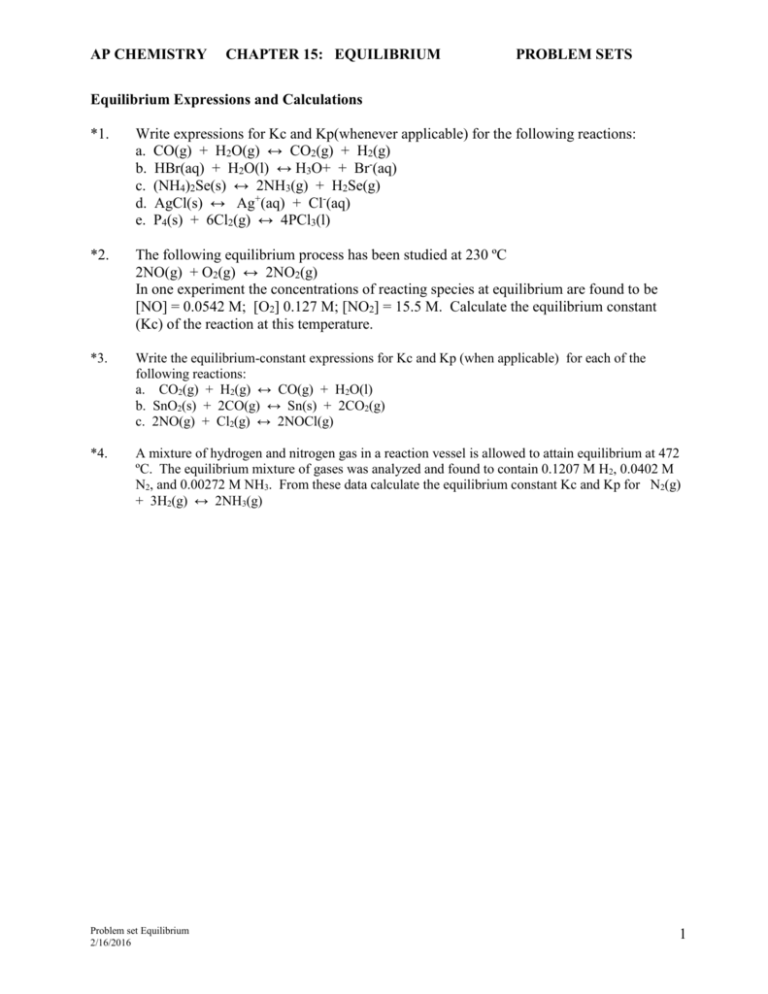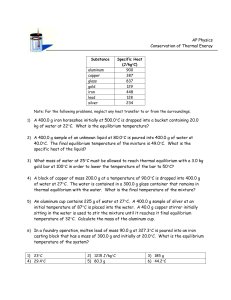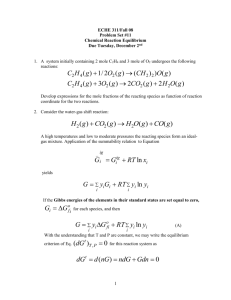AP Chemistry Equilibrium Problem Set
advertisement

AP CHEMISTRY CHAPTER 15: EQUILIBRIUM PROBLEM SETS Equilibrium Expressions and Calculations *1. Write expressions for Kc and Kp(whenever applicable) for the following reactions: a. CO(g) + H2O(g) ↔ CO2(g) + H2(g) b. HBr(aq) + H2O(l) ↔ H3O+ + Br-(aq) c. (NH4)2Se(s) ↔ 2NH3(g) + H2Se(g) d. AgCl(s) ↔ Ag+(aq) + Cl-(aq) e. P4(s) + 6Cl2(g) ↔ 4PCl3(l) *2. The following equilibrium process has been studied at 230 ºC 2NO(g) + O2(g) ↔ 2NO2(g) In one experiment the concentrations of reacting species at equilibrium are found to be [NO] = 0.0542 M; [O2] 0.127 M; [NO2] = 15.5 M. Calculate the equilibrium constant (Kc) of the reaction at this temperature. *3. Write the equilibrium-constant expressions for Kc and Kp (when applicable) for each of the following reactions: a. CO2(g) + H2(g) ↔ CO(g) + H2O(l) b. SnO2(s) + 2CO(g) ↔ Sn(s) + 2CO2(g) c. 2NO(g) + Cl2(g) ↔ 2NOCl(g) *4. A mixture of hydrogen and nitrogen gas in a reaction vessel is allowed to attain equilibrium at 472 ºC. The equilibrium mixture of gases was analyzed and found to contain 0.1207 M H2, 0.0402 M N2, and 0.00272 M NH3. From these data calculate the equilibrium constant Kc and Kp for N2(g) + 3H2(g) ↔ 2NH3(g) Problem set Equilibrium 2/16/2016 1 AP CHEMISTRY CHAPTER 15: EQUILIBRIUM PROBLEM SETS EQUILIBRIUM CONSTANT: BASIC CONCEPTS *1. Determine the value of Kp that corresponds to the following value of Kc: CO(g) + Cl2(g) ↔ COCl2(g) Kc = 1.2 x 103 at 668 K 2. Determine the value of Kc that correspond to the following value of Kp: SO2Cl2(g) ↔ SO2(g) + Cl2(g) Kp = 2.9 x 10-2 at 303 K 3. The equilibrium constant for the reaction ½ H2(g) + ½ I2(g) ↔ HI(g) at 718 K is 7.07. a. What is the value of Kc at 718 K for the reaction: HI(g) ↔ ½ H2(g) + ½ I2(g) ? b. What is the value of Kc at 718 K for the reaction H2(g) + I2(g) ↔ 2HI(g)? 4. Determine Kc at 298 for the reaction 1/2N2(g) + ½ O2(g) + ½ Cl2 ↔ NOCl(g), given the following data at 298 K: 1/2N2(g) + O2(g) ↔ NO2(g) Kp = 1.0 x 10-9 NOCl(g) + ½ O2(g) ↔ NO2Cl Kp = 1.1 x 102 NO2(g) + ½ Cl2(g) ↔ NO2Cl Kp = 0.3 5. A mixture of 5.000 x 10-3 mol of H2 and 1.000 x 10-2 mol of I2 is placed in a 5.000 L container at 448 ºC and allowed to come to equilibrium. Analysis of the equilibrium mixture shows that the concentration of HI is 1.87 x 10-3 M. Calculate Kc at 448 ºC for the reaction: H2(g) + I2(g) ↔ 2HI(g) 6. Are the following reactions reactant- or product favored? a) Cu(NH3)4+2 ↔ Cu+2(aq) + 4NH3(aq) Cd(NH3)4+2 ↔ Cd+2(aq) + 4NH3(aq) K = 1.5 x 10-13 K = 1.0 x 10-7 b) If each reaction in part (a) has a reactant concentration of 0.10 M, in which solution is the NH3 concentration greater? (1). Kp = 22 (5). Kc = 51 Problem set Equilibrium 2/16/2016 (2) Kc = 1.17 x 10-3 (3) (a) 0.141 (b) 50.0 (4) Kc = 1.x10-11 (6) both are reactant favored, in solution 2 [NH3] is greater, explain. 2 AP CHEMISTRY CHAPTER 15: EQUILIBRIUM PROBLEM SETS EQUILIBRIUM CONSTANT: DETERMINING EQUILIBRIUM CONSTANT 1. The brown gas nitrogen dioxide, NO2, can form the colorless gas N2O4. K = 171 at 298 K. Suppose the concentration of NO2 is 0.015M, and the concentration of N2O4 is 0.025 M. Is Q larger than, smaller than, or equal to K? If the system is not at equilibrium, in which direction will the reaction proceed to achieve equilibrium? 2. An aqueous solution of ethanol and acetic acid, each with a concentration of 0.810 M, is heated to 100.0 ºC. At equilibrium, the acetic acid concentration is 0.748 M. Calculate K at this temperature . The reaction is CH3COOH(aq) + C2H5OH(aq) ↔ CH3COOC2H5(aq) + H2O(l) 3. Suppose a tank initially contains H2S with a pressure of 10.00 atm at 800. K. When the reaction 2H2S(g) ↔ 2H2(g) +S2(g) Reaches equilibrium, the partial pressure of S2 vapor is 0.020 atm. Calculate Kp (1) Q<K, not at equilibrium, thus the products will be favored. Problem set Equilibrium 2/16/2016 (2) K = 0.11 (3) 3.2 x 10-7 3 AP CHEMISTRY CHAPTER 15: EQUILIBRIUM PROBLEM SETS USING EQUILIBRIUM CONSTANTS IN CALCULATIONS 1. A mixture of hydrogen and nitrogen gas in a reaction vessel is allowed to attain equilibrium at 472 ºC. The equilibrium mixture of gases was analyzed and found to contain 0.1207 M H2, 0.0402 M N2, and 0.00272 M NH3. From these data calculate the equilibrium constant Kc and Kp for N2(g) + 3H2(g) ↔ 2NH3(g) 2. A mixture of 5.000 x 10-3 mol of H2 and 1.000 x 10-2 mol of I2 is placed in a 5.000 – L container at 448 ºC and allowed to come to equilibrium. Analysis of the equilibrium mixture shows that the concentration of HI is 1.87 x 10-3 M. Calculate Kc at 448 ºC for the reaction: H2(g) + I2(g) ↔ 2HI(g) 3. The equilibrium constant K = 55.64 for H2(g) + I2(g) ↔ 2HI(g) has been determined at 425 ºC. If 1.00 mole each of H2 and I2 are placed in a 0.500 L flask at 425 ºC, what are the concentrations of H2, I2, and HI when equilibrium has been achieved? Quadratic equation w/o approximation 4. The equilibrium constant for the reaction PCl5(g) ↔ PCl3(g) + Cl2(g) has been determined at a given temperature and it was found to be K = 1.20. If the initial concentration of PCl3 is 1.60 M, what will be the equilibrium concentration of reactant and products? Quadratic equation w approximation 5. The reaction N2(g) + O2(g) ↔ 2NO(g) contributes to air pollution whenever a fuel is burned in air at a high temperature, as in gasoline engine. At 1500 K, K = 1.0 x 10-5. Suppose a sample of air has [N2] = 0.80 mol/L and [O2] = 0.20 mol/L before any reaction occurs. Calculate the equilibrium concentration of reactants and products after the mixture has been heated to 1500 K. 1. ( Kc = 0.105; Kp = 2.81 x 10-5 ) (3) [H2]=[I2] = 0.42 M; [HI] = 3.16 M (5) [N2] = 0.80 M; [O2] = 0.20 M; [NO] = 1.26 x 10-3 M Problem set Equilibrium 2/16/2016 2. Kc = 51 (4) [PCl5] = 0.69 M; [PCl3] = [Cl2] = 0.91 M 4 AP CHEMISTRY CHAPTER 15: EQUILIBRIUM PROBLEM SETS CHEMICAL EQUILIBRIUM: REVIEW SHEET 1. A sample of phosgene, COCl2(g), is introduced into a constant-volume vessel at 395 ºC and observed to exert an initial pressure of 0.351 atm. When equilibrium is established, what will be the partial pressure of each gas and what will be the total gas pressure? CO(g) + Cl2(g) ↔ COCl2(g) Kp = 22.5 2. At temperatures near 800ºC, steam passed over hot coke ( a form of carbon obtained from coal) reacts to form CO and H2: C(s) + H2O(g) ↔ CO(g) + H2(g) The mixture of gases that results is an important industrial fuel called water gas (a) At 800 ºC, the equilibrium constant for this reaction is Kc = 0.16. What are the equilibrium concentrations of H2O, CO, and H2 in the equilibrium mixture at this temperature if we start with solid carbon and 0.100 mol of H2O in a 1.00-L vessel? (b) What is the minimum amount of carbon required to achieve equilibrium under these conditions? (c) What is the total pressure in the vessel at equilibrium? (d) At 25 ºC, the value of Kc for this reaction is 7.0 x 10-23. Is the reaction exothermic or endothermic? (e) To produce the maximum amount of CO and H2 at equilibrium, should the pressure of the system be increased or decreased? 3. The pressure of the reacting mixture at equilibrium CaCO3(s) ↔ CaO(s) + CO2(g) is 0.105 atm at 350 ºC. Calculate Kp and Kc. 4. Consider the equilibrium 2NOBr(g) ↔ 2NO(g) + Br2(g) If nitrosyl bromide, NOBr, is 34% dissociated at 25 ºC and the total pressure is 0.25 atm, calculate Kp and Kc for the dissociation at this temperature. 5. Consider the following equilbria involving SO2(g) and thier corresponding equilbrium constants. SO2(g) + ½ O2(g) ↔ SO3(g) K1 2SO3(g) ↔ 2SO2(g) + O2(g) K2 Which of the following expressions relates K1 to K2? (a) K2 = K12 (b) K22 = K1 (c) K2 = K1 (d) K2 = 1/K1 (e) K2 = 1/K12 1. Answer: Pco = PCl2 = 0.105 atm and Pcocl2 = 0.246 atm; Ptotal = 0.456 atm 2. Answers: (a) [CO] = [H2] = 0.070 M; [H2O] = 0.030 M (b)n At least 0.070 mol of C ( c) 15.0 atm (d) endothermic ( K increases with temperature) (e) To maximize the yield, the pressure must be decreased 3. Kp = 0.105; Kc = 2.05 x 10-3; 4. Kp = 9.6 x 10-3 ; Kc = 3.9 x 10-4; 5. (e) Problem set Equilibrium 2/16/2016 5 AP CHEMISTRY CHAPTER 15: EQUILIBRIUM PROBLEM SETS LE CHÂTELLIER’S PRINCIPLE 1. Describe the effect on equilibrium in the reaction of 1-octanol and acetic acid if water is removed from the equilibrium mixture. Explain. CH3(CH2)6CH2OH + CH3COOH ↔ CH3(CH2)6CH2OCOCH3 + H2O. l-octanol acetic acid octyl acetate 2. What would be the effect of each of the following changes on a constant-volume equlibrium mixture of NH3, N2, and H2? Explain. N2(g) + 3H2(g) ↔ 2NH3(g) a. Adding H2(g) 3. b. removing N2(g) c. removing NH3(g) An equilibrium mixture of SO2(g), O2(g), and SO3(g) is transferred from a 1.00 L flask to a 2.00 L flask. In which direction does a net reaction proceed to restore equilibrium? Explain 2SO3(g) ↔ 2SO2(g) + O2(g) 4. Is the amount of NO(g) formed from a given amounts of N2(g) and O2(g) greater at high or low temperatures? Explain. N2(g) + O2(g) ↔ 2NO(g) 5. ΔH = +180.5 kJ Flask A, pictured below, contains an equilibrium mixture in the reaction represented by the following equation: CO(g) + H2O(g) ↔ CO2(g) + H2(g) ΔH = -41 kJ; Kc = 9.03 at 698 K Flask A is connected to flask B, and a new equilibrium is established when the valve between the two is opened. Describe, qualitatively, how the amounts of CO, H2O, CO2, and H2 in the new equilibrium compare to their amounts in the initial equilibrium when the contents of flask B are those listed below. If you are uncertain, explain why. a. Flask B contains Ar(g) at 1 atm pressure b. Flask B contains 1.0 mol CO2. Eq. Mixture CO, H2O, CO2, and H2 A B c. Flask B contains 1.0 mol CO, and the temperature of the A-B assembly is raised by 100 ºC. Problem set Equilibrium 2/16/2016 6 AP CHEMISTRY CHAPTER 15: EQUILIBRIUM PROBLEM SETS 14.28 The pressure of the reacting mixture at equilibrium CaCO3(s) ↔ CaO(s) + CO2(g) is 0.105 atm at 350 ºC. Calculate Kp and Kc. Answer: Kp = 0.105; Kc = 2.05 x 10-3 14.25 Consider the equilibrium 2NOBr(g) ↔ 2NO(g) + Br2(g) If nitrosyl bromide, NOBr, is 34% dissociated at 25 ºC and the total pressure is 0.25 atm, calculate Kp and Kc for the dissociation at this temperature. Answer: Kp = 9.6 x 10-3 ; Kc = 3.9 x 10-4 Problem set Equilibrium 2/16/2016 7 AP CHEMISTRY Problem set Equilibrium 2/16/2016 CHAPTER 15: EQUILIBRIUM PROBLEM SETS 8







